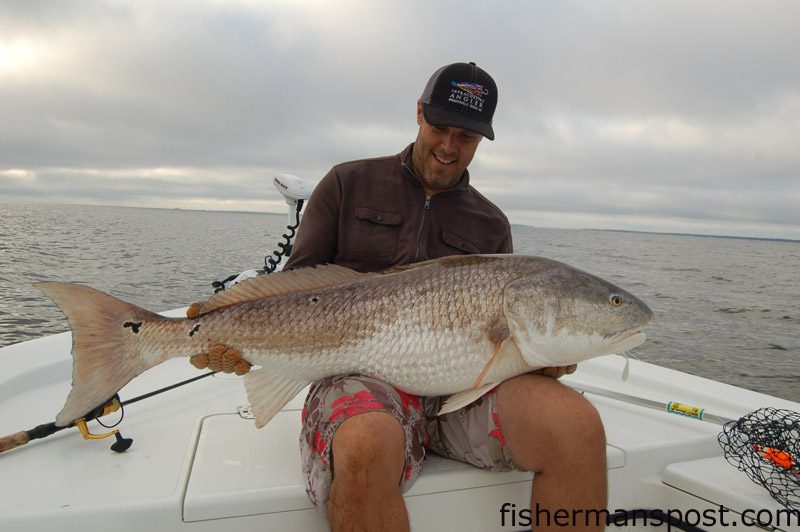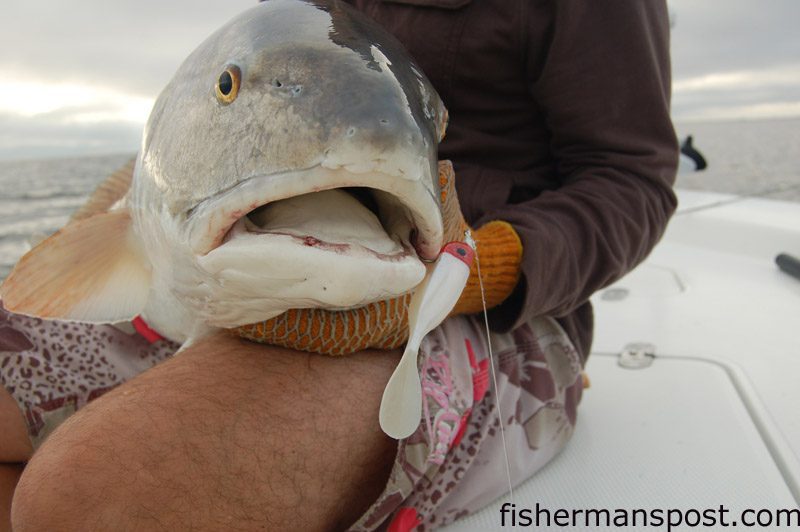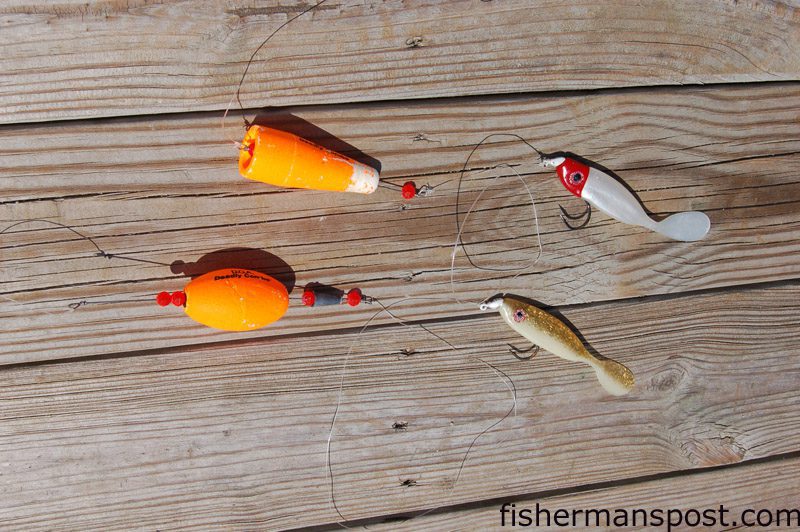Tidelines – August 22, 2013

Gary Hurley with his first citation red drum that was caught on a DOA soft plastic under a popping cork. He was casting on a shoal edge with Capt. Gary Dubiel, of Spec Fever Guide Service.
Capt. Gary Dubiel, of Spec Fever Guide Service, has successfully challenged my way of looking at citation-class red drum fishing in the Pamlico/Neuse area. And if you’ve ever done the bait fishing for big reds in the Pamlico/Neuse (or if it’s a bucket list trip of yours), then I highly encourage you to let Gary Dubiel challenge you, too.
The typical big red drum trip is heading out in the late afternoon, anchoring up on the edge of a shoal, putting out six rods with six cut baits on the bottom, and waiting into the night for one of the rods in the rod holders (or sometimes two and three rods at a time) to bend over and scream drag announcing that you’re hooked to a big red. It’s a fun, easy, and social trip that regularly produces catch-and-release photos and memories that last a long, long time.
Dubiel has successfully done these bait trips for years, and he continues to do so, but he’s recently innovated a brand new way to target these big reds. And his way not only seems to produce more fish, but it also creates a stronger sense of accomplishment in the angler because it is the angler (and not the captain or the rod holder) that casts to and hooks a big red before fighting it to the boat.
Dubiel’s new tactic is rather simple. He fishes during the day in waters known to typically hold the big reds—shoal edges where boats would anchor up at night for the same fish—and he drifts along those edges working the water with soft plastics hanging under popping corks.
That’s how Dubiel and I targeted big reds on our trip together this past Sunday morning, and we hooked four fish by 7:30 am on a day where bait fishermen on the radio were reporting at lunch that it was a slow day with little to no bites (the bite had been good for days, but on Saturday night a northeast wind had switched to a northwest wind causing the water level around Oriental to fall about two feet, and as a result the bite had slowed considerably for most).

A DOA Airhead hangs from the mouth of a big red drum caught and released in the Nesue River outside of Oriental. The fish was working in 7′ of water just off a shoreline.
For our trip, he took me to a shoal a short run out of the Oriental public boat ramp where we pulled off plane upwind of the body of water he wanted to target. The trolling motor was used as sparingly as possible, mostly just to control the drift of the boat (for the best success rates, Dubiel likes to limit any kind of noise as much as possible), and I started casting a DOA CAL jerkbait (5 ½”) under a DOA popping cork (beveled to produce a noisier pop and disturb the water surface more, and weighted to help with distance when casting).
On my second cast and on either the third or fourth “pop,” the water boiled around my bobber and suddenly I was fast to a big red screaming drag as it headed for deeper water. I’ve fought my share of the citation-class red drum, but this hookup and fight was different. It was more satisfying because this red drum bit an artificial that I had cast myself and worked through the water. The rod was in my hand and not in a rod holder when the bite came, and to me that increased responsibility produces a stronger connection with the fish.
What soft plastic you use isn’t very important (although, unscented baits work better as scented baits attract too many undesirables, and larger soft plastics seem to produce more bites than smaller ones), but the popping cork is key, he explained, as the noise is a large part of the success of this technique. The reds key in on the noise, imagining it to be either bait fish or something feeding on the bait fish, and then when they come over to inspect they find a high-profile soft plastic bait too tempting to turn down.
Noise, though, can also be the Achilles heel of this technique. Dubiel has had regular success with popping corks in all kinds of conditions, from lots of wind and choppy conditions to no wind and glassy, on both cool mornings/afternoons and in the midday heat, during sunny days or overcast, and with clear or muddied water—that’s one of the beauties of this type of fishing, especially from the guide’s perspective, is that conditions don’t have to be perfect to make it possible to cast soft plastics under bobbers to the big reds.
While weather and water conditions matter little, the noise of boat traffic, however, can quickly turn off the bite. These big fish are constantly on the move and covering large areas, so the disturbance of a boat engine even as close as 100 yards away can easily cause the fish to go down and disappear.

Two casting rigs that Capt. Gary Dubiel uses regularly when targeting citation class red drum–a DOA Oval Clacker and a DOA popping cork, 20-24″ of 50 lb. mono leader, and DOA Airhead soft plastics.
And this issue of noise leads into the double edge sword of what Dubiel is trying to accomplish. He wants to popularize fishing for reds during the day with his popping cork technique, but popularity will put more boats on the water. More boats on the water equals more noise, and noise works against success.
On our trip together, I asked Dubiel why he wanted to share his technique—why not try to keep it to himself. He explained that what he wants, and I think this is understandable, is to be credited with his innovation. A year or so from now when more people start changing the way they target these big drum (just this past week about five local guides had called Dubiel to ask about his technique), Dubiel would like to be recognized as the person who first introduced popping corks to this fishery.
Of course, he would also like to book some trips to take people fishing for the big reds with popping corks and soft plastics. After all, Spec Fever Guide Service is how he pays the bills. He wants to take people out who have only tried bait fishing for these big reds (or people who have yet to experience this wonderful fishery we have in North Carolina) and show them the satisfaction and enjoyment of casting to and setting the hook on a citation-class red drum during the day.
Like I said at the start of my article, I am a believer. I saw firsthand that popping corks worked and believe this new method will be game changing. Dubiel gave me an eye opening, unique, and memorable fishing trip, and I want to thank him. I want to help Dubiel be recognized as the innovator of this popping cork technique, and I want to help him book trips and show other people firsthand this new style of red drum fishing.
You can reach Capt. Gary Dubiel at (252) 249-1520 or by email at captgary@specfever.com, but perhaps the best way to follow him and the ongoing results of these popping cork trips is to follow him on Facebook. He’ll be fishing for citation reds through September and into October, so I encourage you to reward yourself with a Dubiel popping cork trip. Consider it a challenge.
